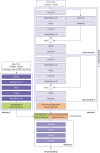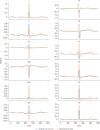Identifying Atrial Fibrillation With Sinus Rhythm Electrocardiogram in Embolic Stroke of Undetermined Source: A Validation Study With Insertable Cardiac Monitors
- PMID: 37973386
- PMCID: PMC10654409
- DOI: 10.4070/kcj.2023.0009
Identifying Atrial Fibrillation With Sinus Rhythm Electrocardiogram in Embolic Stroke of Undetermined Source: A Validation Study With Insertable Cardiac Monitors
Abstract
Background and objectives: Paroxysmal atrial fibrillation (AF) is a major potential cause of embolic stroke of undetermined source (ESUS). However, identifying AF remains challenging because it occurs sporadically. Deep learning could be used to identify hidden AF based on the sinus rhythm (SR) electrocardiogram (ECG). We combined known AF risk factors and developed a deep learning algorithm (DLA) for predicting AF to optimize diagnostic performance in ESUS patients.
Methods: A DLA was developed to identify AF using SR 12-lead ECG with the database consisting of AF patients and non-AF patients. The accuracy of the DLA was validated in 221 ESUS patients who underwent insertable cardiac monitor (ICM) insertion to identify AF.
Results: A total of 44,085 ECGs from 12,666 patient were used for developing the DLA. The internal validation of the DLA revealed 0.862 (95% confidence interval, 0.850-0.873) area under the curve (AUC) in the receiver operating curve analysis. In external validation data from 221 ESUS patients, the diagnostic accuracy of DLA and AUC were 0.811 and 0.827, respectively, and DLA outperformed conventional predictive models, including CHARGE-AF, C2HEST, and HATCH. The combined model, comprising atrial ectopic burden, left atrial diameter and the DLA, showed excellent performance in AF prediction with AUC of 0.906.
Conclusions: The DLA accurately identified paroxysmal AF using 12-lead SR ECG in patients with ESUS and outperformed the conventional models. The DLA model along with the traditional AF risk factors could be a useful tool to identify paroxysmal AF in ESUS patients.
Keywords: Artificial intelligence; Atrial fibrillation; Electrocardiogram; Embolic stroke.
Copyright © 2023. The Korean Society of Cardiology.
Conflict of interest statement
Medical AI Inc. provided support in the form of salaries for authors (Jong-Hwan Jang, Sora Kang, Hak Seung Lee, Min Sung Lee, Jeong Min Son, Yong-Yeon Jo, Tae Jun Park, and Joon-myoung Kwon). Joon-myoung Kwon is the founder and stakeholder in Medical AI Inc., a medical artificial intelligence company. There are no patents, products in development of marketed products to declare. This does not alter our adherence to
Figures





References
-
- Ntaios G. Embolic stroke of undetermined source: JACC review topic of the week. J Am Coll Cardiol. 2020;75:333–340. - PubMed
-
- Kirchhof P, Benussi S, Kotecha D, et al. 2016 ESC Guidelines for the management of atrial fibrillation developed in collaboration with EACTS. Europace. 2016;18:1609–1678. - PubMed
-
- Ziegler PD, Rogers JD, Ferreira SW, et al. Long-term detection of atrial fibrillation with insertable cardiac monitors in a real-world cryptogenic stroke population. Int J Cardiol. 2017;244:175–179. - PubMed
LinkOut - more resources
Full Text Sources
Research Materials

